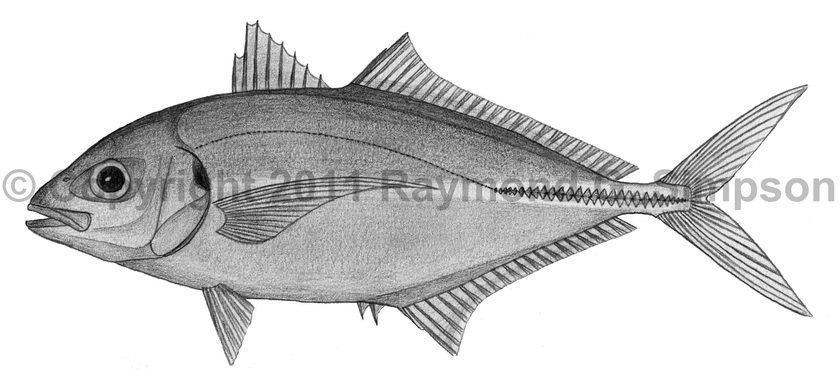
Common Name
White Trevally
Year Described
Bloch & Schneider, 1801
Identification
Dorsal Fin: 8 spines in first lobe, followed by I, 25-27
Anal Fin: 2 spines separate from rest, followed by I, 21-26
Pelvic Fin: I, 5
Gill Rakers: 11-14 upper, 23-28 lower
Vertebrae: 10 precaudal, 15 caudal
Elongate and deep-bodied, with a large head and small eye (4.4-5.3 times in HL). Adipose eyelid weak. Jaw does not reach anterior margin of eye. Lips covered in papillae. Teeth blunt, usually in a single row in both jaws. Pectoral fins falcate, longer than head. Spiny dorsal fin higher than lobe of second dorsal fin. Anterior lobe of anal fin also slightly raised. Tail deeply forked. Lateral line with curved anterior portion containing 57-78 scales and a straight posterior portion with 2-27 scales and 16-31 scutes. Small cycloid scales on entire body, including chest. Caudal keels absent.
Color
Bright silvery, darkening to blue-green above. A dark spot on the upper opercular edge. Yellow stripe on side broadens posteriorly. Yellow stripes on dorsal and ventral midline runs along fin bases. Dorsal, anal, and caudal fins yellow to dusky.
Size
Common to 40cm. Maximum size to 82cm.
Habitat
Inshore from the surface to over sandy and hard bottoms. Juveniles often in bays and estuaries.
Range
Found off Bermuda and the SE U.S. from North Carolina to Georgia, and also in the S. Hemisphere off Brazil.
References
Smith-Vaniz, W.F. 2003. Carangidae (pp 1426-1468). In: Carpenter. 2003. The living marine resources of the Western Central Atlantic v. 3.